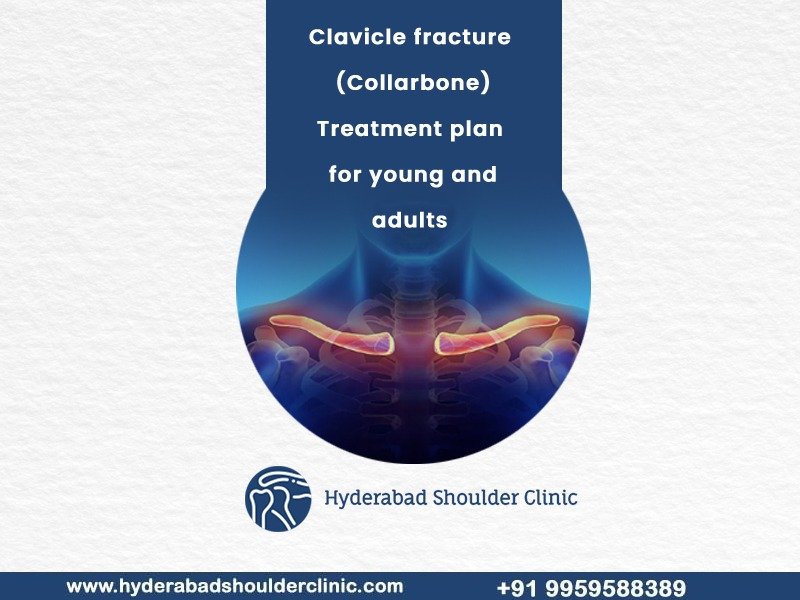Collarbones are the two slender bones that start from the top of your sternum and extend out to each shoulder blade. A broken collarbone is a fracture in one of your clavicles as a result of trauma to your shoulder. Expert shoulder surgeons like Dr.Chandra Sekhar B use various terms to describe your fracture, such as:
Singular/comminuted: If the clavicle bone is broken in more than one place, it’s called a comminuted fracture.
Displaced /nondisplaced: If the clavicle bone moves out of its original position after the fracture, it’s called a displaced fracture.
Out of all the bone fractures, collarbone injuries account for 5% to 10% of all. In children, it is 10% to 15% and is the most common fracture in childhood overall.
Clavicle fracture (Collarbone) Treatment plan for young and adults – Symptoms and Causes
Shoulder pain: The patient experiences pain in the shoulder or closer to the middle of the bone, at the base of the neck, depending on where it’s broken.
Restricted movement: The shoulder might feel stiff or painful while trying to move. Grinding or crackling sounds can be heard while driving.
Swelling: The soft tissues around the fracture swell due to inflammation. Misalignment: The fracture will be visible, and the shoulder might seem to slump unnaturally, or your collarbone might look asymmetrical.
Bruising: The site of fracture might be darkened or discoloured along your collarbone.
What are the common causes of clavicle fractures?
Common causes include:
- Falls.
- Collisions.
- Car accidents.
- Birth trauma where their shoulders get stuck in the birth canal can cause clavicle fractures.
Clavicle fracture (Collarbone) Treatment plan for young and adults – Diagnosis and Tests
A healthcare provider will take the following steps :
- Enquire about the cause of trauma and may ask you to describe in detail
- Physical examination of the area.
- X-rays to show where your break is, what type it is, and if any other bones are broken.
- In case of complex injuries, a CT scan is done to see them in more detail.
Clavicle fracture (Collarbone) Treatment plan for young and adults – Management and Treatment
Clavicle fractures in young adults heal well with conservative treatment, with only a tiny percentage requiring surgery.
Immobilization: During the period of healing, it’s essential to keep the bone pieces from moving around. A sling or shoulder immobilizer can hold the bone still, and one has to wear it for several weeks.
Pain relief: Pain medications during the first week or two of recovery, following which you can use over-the-counter (OTC) pain relievers.
Apply ice to the fracture for about 20 minutes at a time.
Observation: You will have to continue your check-up with your doctor while the fracture heals. During this period, X-rays are taken to make sure it’s healing correctly. If the X-rays reveal any failure to heal completely (disunion), they may need to intervene.
Physical therapy: As healing progresses, gentle exercises are suggested to prevent your soft tissues from stiffening too much while immobilized. After complete healing, you can work on rebuilding your muscle strength.
Surgery for Clavicle fracture (Collarbone) Treatment plan for young and adults
Surgery is done in the case of :
- The bone pieces have shifted far out of place – Displaced clavicle fracture
- Apart from bone injury if there are injuries to tendons, ligaments, blood vessels, or nerves.
The aim of a surgery for a broken collarbone is to:
- Put the broken pieces back together – open reduction
- Holding them in place with pins or plates and screws – internal fixation
Recovery from a fractured collarbone
Clavicle fracture recovery times vary based on the severity of the fracture. Young ones heal faster as their bones are still growing. Healing times are as follows:
- Eight to 12 weeks for adults.
- Six to eight weeks for adolescents.
- Three to six weeks for kids under 8.
- It takes about two weeks for an infant.
Return to sports: One can return to sports only if their collarbones have fully healed and there’s no more pain with movement. It would help if you did strength-building exercises.
Long-term complications: Most clavicle fractures heal entirely, but if they fail to heal on their own, it may cause ongoing pain until a surgeon fixes it. Misalignment can cause lasting visible bone deformity.
Bone calluses: Children may develop a visible lump on their bone at the fracture site, known as a bone callus. It will reduce over time, like in a year, but sometimes, a small lump remains.
When should I contact my healthcare provider on an emergency basis?
Contact a healthcare provider right away under the following circumstances:
- Shortness of breath.
- Tingling or numbness.
- Weakness or faintness.
- New or increased pain.
The collarbone itself is not vulnerable to injury, but its connection to the shoulder makes it so. Significant trauma to the shoulder gets transferred to the collarbone. Kids are more susceptible to these collarbone fractures. We at Hyderabad Shoulder Clinic are very thorough in our diagnosis and treatment. We give the utmost importance to the recovery phase in terms of follow-ups, physical therapy, and medications. For more information, please visit our website https://hyderabadshoulderclinic.com/ or contact us at +91 9959588389 or shoulderandsportsclinic@gmail.com.





